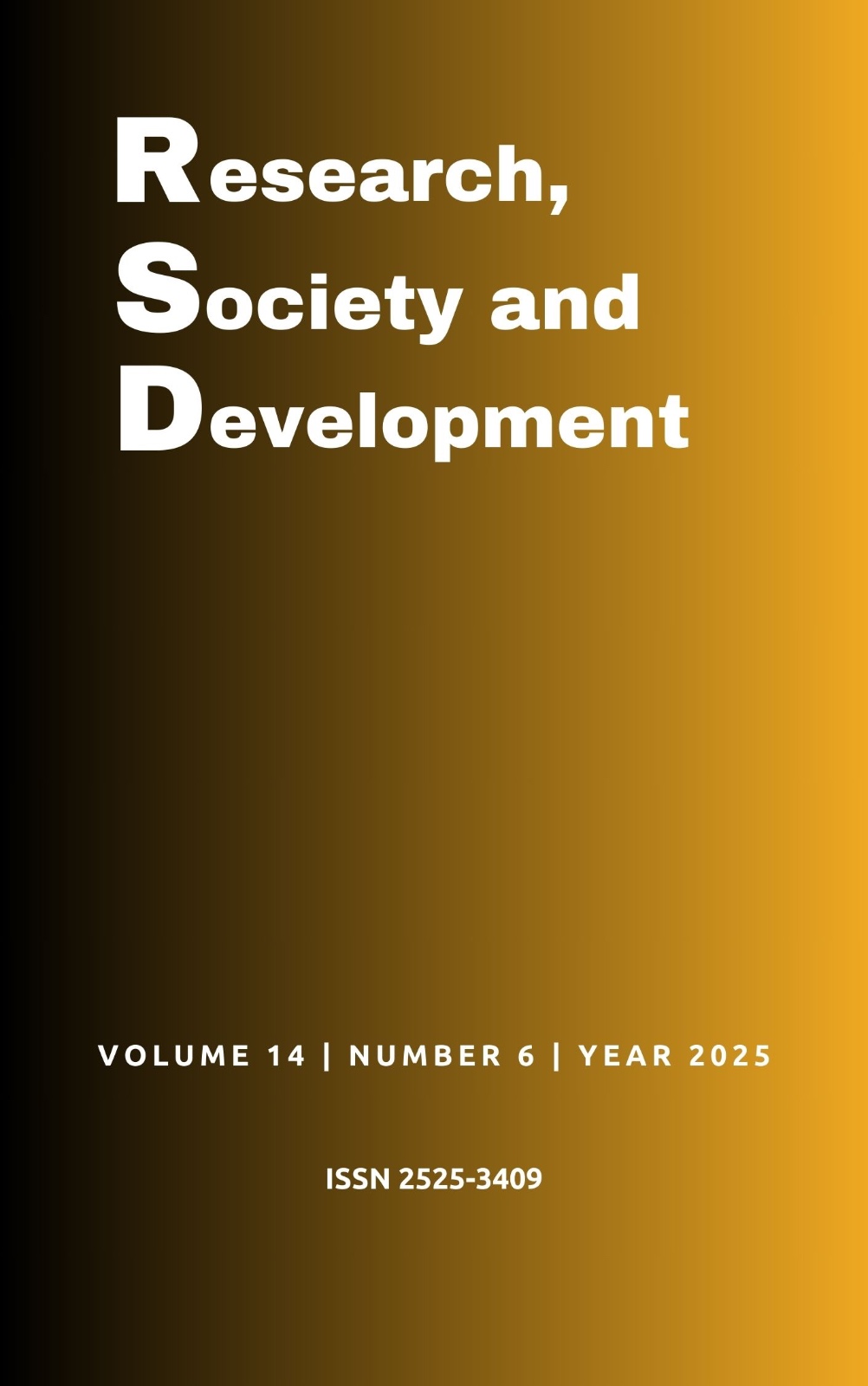Insulin resistance and its relationship with food choices and lifestyle among adolescents
DOI:
https://doi.org/10.33448/rsd-v14i6.48962Keywords:
Insulin resistance, Adolescents, Obesity, Lifestyle.Abstract
Insulin resistance (IR), defined as decreased cell sensitivity to the action of insulin, is a relevant risk factor for the development of chronic non-communicable diseases (NCDs). In recent decades, the sharp increase in obesity rates and sedentary lifestyles among adolescents has contributed significantly to the increased prevalence of this metabolic dysfunction. This study aims to investigate the relationship between IR and behavioral, dietary, genetic, and psychosocial factors that affect the adolescent population. Evidence indicates that inadequate dietary patterns, characterized by excessive consumption of sugars and ultra-processed foods, associated with physical inactivity, play a determining role in the emergence of IR. Furthermore, socioeconomic, cultural, and family environment factors have been shown to have a direct influence on the dietary choices and lifestyle of young people, increasing metabolic risk. To achieve the proposed objectives, a literature review will be carried out based on scientific articles available in the PubMed and SciELO databases, among others, with the inclusion criteria being articles published in the last ten years and clinical trials related to the topic.
References
ABESO. (2015). PeNSE - 2015: Pesquisa Nacional de Saúde do Escolar. Associação Brasileira para o Estudo da Obesidade (ABESO).
Andrade, M. I. S. (2019). Consumo alimentar de micronutrientes antioxidantes e resistência à insulina em adolescentes brasileiros. Tese (Doutorado) em Nutrição na UFPE. Repositório Attena. https://repositorio.ufpe.br/handle/123456789/34330.
Anima. (2014). Manual revisão bibliográfica sistemática integrativa: a pesquisa baseada em evidências. Grupo Anima.
Barbosa, R. P. (2022). Prevalência de síndrome metabólica em pacientes com sobrepeso/obesidade acompanhados em ambulatório de nutrição: Universidade Federal de Ouro Preto.
Benavides, C. et al. (2022). eHealth Intervention to Improve Health Habits in the Adolescent Population: Mixed Methods Study. JMIR Mhealth Uhealth. 6(2), e25245. Doi: 10.2196/20217.
Bikman, B. et al. (2022). A high-carbohydrate diet lowers the rate of adipose tissue mitochondrial respiration. European Journal of Clinical Nutrition. 76(9), 1339-42. Doi: 10.1038/s41430-022-01097-3
Brito, A. N. M. et al. (2020). Padrão alimentar e resistência à insulina em adolescentes. Research, Society and Development. 9(12).
Doi: https://doi.org/10.33448/rsd-v9i12.10786.
Coêlho, S. N. S. et al. (2017). Avaliação da resistência insulínica em adolescentes com diferentes estados nutricionais. Adolesc. Saúde. 14(3), 71-6.
Corgosinho, F. C. et al. (2015). Beneficial effects of a multifaceted 1-year lifestyle intervention on metabolic abnormalities in obese adolescents with and without sleep-disordered breathing. Metabolic Syndrome and Related Disorders. 13 (3), 110–8. Doi: 10.1089/met.2014.0110.
Crossetti, M. G. M. (2012). Revisión integradora de la investigación en enfermería el rigor científico que se le exige. Maria Da Graça Oliveira Crossetti. Rev. Gaúcha Enferm. 33(2), 8-9.
Faria, E. R. et al. (2014). Resistência à insulina e componentes da síndrome metabólica: análise por sexo e por fase da adolescência. Arq. Bras. Endocrinol. Metab. 58(6), 610-8. Doi: 10.1590/0004-2730000002613.
Freitas, M. C., Ceschini, F. L. & Ramalho, B. T. (2014). Resistência à insulina associado à obesidade: efeitos anti-inflamatórios do exercício físico. R. Bras. Ci e Mov. 22 (3), 139-47.
Gobato, A. O. et al. (2014). Metabolic syndrome and insulin resistance in obese adolescents. Rev. Paul. Pediatr. 32(1), 55-62.
Doi: 10.1590/S0103-05822014000100010.
Guimarães, M. R. et al. (2019). Alterações clínicas, metabólicas e resistência à insulina entre adolescentes. Acta Paul. Enferm. 32(6), 608-16.
Doi: 10.1590/1982-0194201900085.
Hobold, E. & Arruda, M. (2015). Prevalência de sobrepeso e obesidade em estudantes: relações com nível socioeconômico, sexo e idade. Revista Brasileira de Cineantropometria e Desempenho Humano. 17(2), 156-64. Doi: http://dx.doi.org/10.5007/1980-0037.2015v17n2p156.
Joseph, C. R., Kumar, H. & Bhat, K. B. (2023). Cross-sectional observational study on correlation of obesity and overweight in children with insulin resistance based on HOMA-IR score. Open Journal of Pediatrics and Child Health. 8(1), 39-44. Doi: 10.17352/ojpch.000050.
Jurkovičová, J. et al. (2021). The Prevalence of Insulin Resistance and the Associated Risk Factors in a Sample of 14–18-Year-Old Slovak Adolescents. International Journal of Environmental Research ad Public Health. 18(909), 1-19. Doi: 10.3390/ijerph18030909.
Mendes, P. S. et al. (2023). Efeito da atividade física em crianças e adolescentes com síndrome metabólica. In: SciELO pré prints. Doi: https://doi.org/10.1590/SciELOPreprints.8066. https://preprints.scielo.org/index.php/scielo/preprint/view/8066/version/8527.
Pereira A. S. et al. (2018). Metodologia da pesquisa científica. [free e-book]. Editora UAB/NTE/UFSM.
Pérez, M. A. et al. (2015). Relación circunferencia de cintura/talla: Predictor de insulino-resistencia y agrupamiento de factores de riesgo cardiometabólico en adolescentes. Archivos Venezolanos de Puericultura y Pediatría. 78(1), 14–23.
Rojas-Gabulli, M. I. et al. (2021). Resistencia a insulina en adolescentes obesos. Revista de la Facultad de Medicina Humana. 21(3), 123–30.
Sena, B. S. (2023). Desempenho diagnóstico de índices de adiposidade na identificação de resistência à insulina em adolescentes pós-púberes brasileiros. Dissertação (Mestrado em Nutrição) – Universidade Federal de Pernambuco.
Snyder, H. (2019). Literature review as a research methodology: An overview and guidelines. Journal of business research, 104, 333-339.
Tagi, V. M. & Chiarelli, F. (2020). Obesity and insulin resistance in children. Current Opinion: Pediatrics. 32(4), 582-8. Doi: 10.1097/MOP.0000000000000913
Downloads
Published
Issue
Section
License
Copyright (c) 2025 Maria Alice Alves Reis; Manuela Neves Castello Branco; Daniela de Araujo Medeiros

This work is licensed under a Creative Commons Attribution 4.0 International License.
Authors who publish with this journal agree to the following terms:
1) Authors retain copyright and grant the journal right of first publication with the work simultaneously licensed under a Creative Commons Attribution License that allows others to share the work with an acknowledgement of the work's authorship and initial publication in this journal.
2) Authors are able to enter into separate, additional contractual arrangements for the non-exclusive distribution of the journal's published version of the work (e.g., post it to an institutional repository or publish it in a book), with an acknowledgement of its initial publication in this journal.
3) Authors are permitted and encouraged to post their work online (e.g., in institutional repositories or on their website) prior to and during the submission process, as it can lead to productive exchanges, as well as earlier and greater citation of published work.


